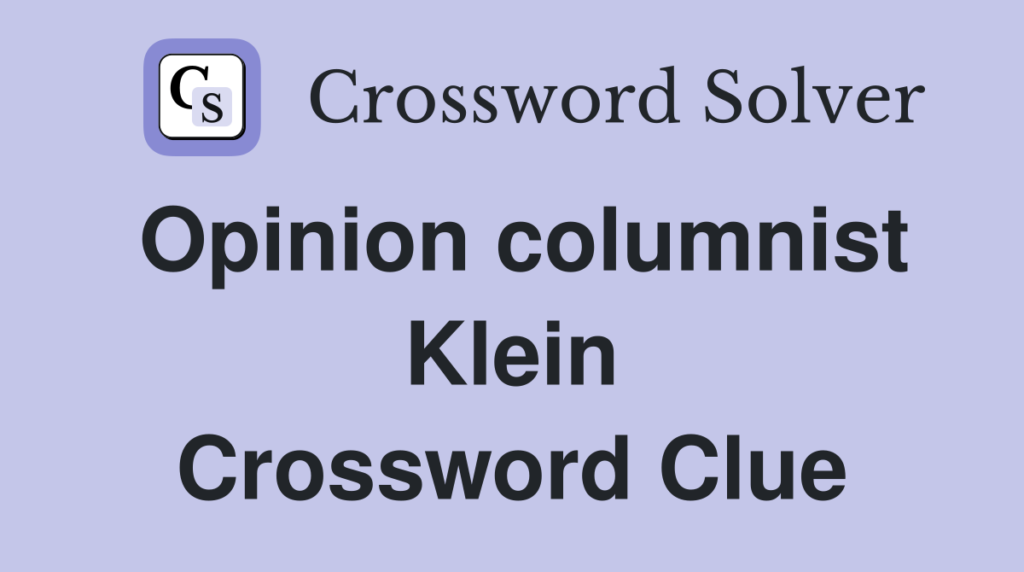Opinion columnists keep a completely unique and influential position in the media landscape, supplying insights, evaluation, and perspectives that shape public discourse. One such columnist who has made substantial contributions is Ezra Klein, a distinguished creator and commentator associated with The New York Times. Alongside Klein’s notion-provoking columns, The New York Times Crossword stands as another cultural staple, enticing readers with its combo of project and amusement. This article delves into the impact of opinion columnists like Klein and the long-lasting attraction of the crossword puzzle in the context of The New York Times.
The Influence of Ezra Klein
Background and Career
Ezra Klein is a well-known journalist, political analyst, and commentator who co-founded Vox, a news internet site recognised for its explanatory journalism. In 2021, Klein joined The New York Times as an opinion columnist, where he continues to offer in-depth evaluation on politics, policy, and culture. His paintings is characterised by means of a nuanced know-how of complex problems, clear articulation, and a willpower to informing his readers.
Contributions to Public Discourse
Klein’s columns regularly recognition at the intersection of politics, economics, and society. He explores subject matters such as healthcare, weather alternate, economic inequality, and the mechanics of democracy. His capability to interrupt down complex subjects into handy narratives has made his columns a treasured resource for readers in search of to apprehend the forces shaping current existence.
Klein’s writing now not best informs but also sparks dialogue and debate. By presenting properly-researched arguments and engaging with lots of views, he encourages readers to assume seriously approximately the problems handy. This function as a facilitator of public discourse is critical in a democratic society, in which informed citizens are important for the functioning of the political machine.
Impact on Readers
The effect of Klein’s work may be seen in the robust discussions that his columns frequently generate. Readers frequently engage along with his ideas through feedback, social media, and other forums, reflecting a dynamic change of thoughts and evaluations. This interaction underscores the significance of opinion columnists in fostering a extra knowledgeable and engaged public.
The New York Times Crossword: A Cultural Staple
History and Evolution
The New York Times Crossword, first posted in 1942, has turn out to be an iconic feature of the newspaper. Created by using Arthur Wynne, the crossword puzzle has developed over the a long time, adapting to changes in tradition, language, and technology. Today, it remains a cherished hobby for lots, known for its smart clues and varying ranges of problem.
The Appeal of the Crossword
Part of the crossword’s enduring attraction lies in its potential to challenge and entertain. Solvers appreciate the intellectual stimulation and the satisfaction of completing a puzzle. The crossword additionally gives a experience of continuity and culture, connecting generations of solvers who proportion a love for wordplay and trouble-fixing.
The New York Times Crossword is extra than only a puzzle; it is a cultural phenomenon. It reflects and impacts language, regularly incorporating modern slang, popular culture references, and modern-day events. This responsiveness to the zeitgeist keeps the crossword applicable and tasty for a numerous target audience.
The Crossword Community
The crossword network is colourful and energetic, with solvers starting from informal fans to devoted experts. Online boards, blogs, and social media structures provide spaces for solvers to talk about puzzles, proportion recommendations, and rejoice their achievements. This feel of network enhances the enjoy of fixing and fosters a deeper connection to the puzzle.
The Intersection of Journalism and Entertainment
Complementary Roles
Opinion columns and crossword puzzles would possibly appear like disparate elements of a newspaper, however they supplement every different in meaningful methods. While columnists like Ezra Klein offer readers with critical analysis and notion-provoking perspectives, the crossword puzzle offers a shape of mental workout and enjoyment. Together, they make a contribution to a nicely-rounded studying revel in that engages both the mind and the creativeness.
Enhancing Reader Engagement
Both opinion columns and crossword puzzles play a position in enhancing reader engagement. Opinion portions invite readers to bear in mind new viewpoints and participate in ongoing debates, whilst the crossword puzzle challenges them to suppose creatively and strategically. This mixture of content keeps readers coming lower back, fostering loyalty and a deeper connection to the newspaper.
Educational Value
There is likewise an academic dimension to each columns and crosswords. Opinion columns, via providing in-depth evaluation and context, help readers broaden a better knowledge of complex troubles. The crossword puzzle, on the other hand, complements vocabulary, improves problem-fixing abilities, and encourages lateral questioning. Together, they make contributions to a extra knowledgeable and intellectually curious readership.
The Enduring Relevance of Traditional Media
Adaptation to Digital Platforms
The New York Times has successfully tailored each its opinion columns and crossword puzzles to digital platforms. Klein’s columns are easily reachable on-line, where they could attain a much broader target market and facilitate instant reader interaction thru remarks and social media. Similarly, the crossword puzzle is available in digital format, allowing solvers to have interaction with it on their devices.
Balancing Tradition and Innovation
While embracing digital innovation, The New York Times has maintained the exceptional and integrity of its traditional offerings. This balance between culture and innovation is prime to the newspaper’s ongoing relevance. By retaining the center factors that have made its opinion columns and crossword puzzles cherished via readers, The New York Times keeps to thrive in a changing media panorama.
Conclusion
Opinion columnists like Ezra Klein and the iconic New York Times Crossword each play large roles in shaping the newspaper’s identification and effect. Klein’s insightful analysis and engaging writing foster knowledgeable public discourse, at the same time as the crossword puzzle presents highbrow undertaking and enjoyment. Together, they beautify the reader’s enjoy, balancing severe mirrored image with playful engagement. As The New York Times keeps to adapt to the virtual technology, the enduring appeal of its columns and crossword puzzles underscores the lasting significance of considerate journalism and engaging content material.

